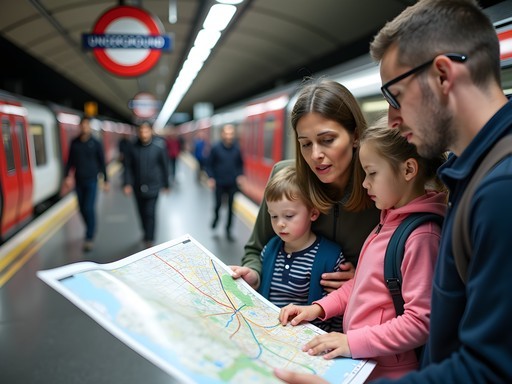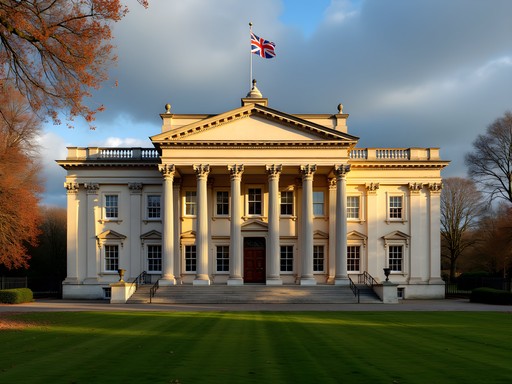Disclosure: This article contains affiliate links. We may earn a commission from purchases at no extra cost to you, which helps our travel content.
As someone who's spent her life navigating between different cultures and transportation systems—from Frankfurt's efficient U-Bahn to rural Mexican bus routes—I've developed a knack for quickly mastering public transit in new cities. But London's iconic network holds a special place in my heart. The first time I saw that round blue and red Underground symbol, I felt the same excitement as when I spotted my first Thames houseboat! After multiple visits and countless miles traveled on London's extensive network, I've compiled everything families need to know about navigating this magnificent city without breaking the bank. Whether you're traveling with energetic kids, mobility-challenged grandparents, or just trying to squeeze the most value from your travel budget, this guide will transform you from confused tourist to confident navigator faster than you can say 'mind the gap.'
Understanding London's Transport Network
London's integrated transport network is a marvel of engineering and planning that dates back to 1863 when the world's first underground railway opened. Today, it consists of multiple interconnected systems that can take you virtually anywhere in Greater London.
The Underground (The Tube): London's subway system is divided into 11 color-coded lines spanning 402 km and serving 272 stations. It's the fastest way to travel between major destinations and the backbone of London's transport network. The iconic Tube map, with its simplified geometric design, makes navigation surprisingly intuitive once you understand the basics.
Buses: With over 700 routes, London's distinctive red double-decker buses offer the most comprehensive coverage of the city. They're slower than the Tube but provide scenic views and access to areas the Underground doesn't reach. For families, the front seats on the upper deck are prime real estate—my niece and nephew fought over these spots during our last visit!
Overground and DLR: These above-ground rail networks complement the Underground, connecting outer boroughs and providing crucial links to areas like East London and Canary Wharf. The Docklands Light Railway (DLR) is particularly fun for kids as the trains are driverless, so sitting at the front gives you a roller-coaster-like view.
River Bus Services: Don't overlook the Thames Clippers! These boat services run from Putney to Woolwich, offering a scenic alternative to underground travel and stunning views of landmarks like the Houses of Parliament and Tower Bridge. Mein Gott, the perspective from the water is something special—reminds me of my houseboat adventures, just with more historic architecture!
Cycling: Santander Cycles (locally known as 'Boris Bikes') provide an eco-friendly option for short journeys, with over 750 docking stations across central London. Just be aware that London traffic can be intimidating if you're not an experienced urban cyclist.

💡 Pro Tips
- Download the TfL Go app for real-time updates and journey planning
- Grab a free Tube map at any station to help with navigation
- Look for the yellow card readers when transferring between lines to ensure you're charged correctly
Oyster Cards and Payment Options: The Smart Way to Save
When I first visited London as a budget-conscious student, I made the rookie mistake of buying individual paper tickets. Don't repeat my error! The payment system for London transport might seem complex, but understanding it will save your family significant money.
Oyster Card: This reloadable smart card is the traditional way to pay for transport in London. You pay a £7 refundable deposit and then load it with credit (pay-as-you-go) or travel cards (unlimited travel within specific zones for a set period). The beauty of Oyster is that it automatically caps your daily spending at the price of a Day Travelcard, so you never pay more than necessary.
Contactless Payment: If your bank card has the contactless symbol, you can simply tap it on the yellow readers just like an Oyster card. The same daily and weekly caps apply, and it eliminates the need to queue for tickets or top up an Oyster card. This has become my go-to method—so praktisch (so practical)!
Mobile Payment: Apple Pay, Google Pay, and similar services work exactly like contactless bank cards. I keep my phone in a phone wallet case that protects my device while keeping my transit card accessible—essential when you're juggling kids and luggage!
Visitor Oyster Card: You can order these before arriving in London, and they come pre-loaded with credit and offer special discounts on attractions. They're convenient but not necessary if you have contactless payment options.
Group and Family Travel: Children under 11 travel free on buses and trams without any special ticket. On the Tube, up to four children under 11 can travel free with each fare-paying adult. For older children (11-15), get a Zip Oyster Photocard for discounted travel.
For my family of four visiting for a week, I calculated a savings of nearly £80 using Oyster cards with 7-day travelcards compared to buying individual tickets. That's enough for a nice dinner or an extra attraction!

💡 Pro Tips
- Register your Oyster card online to protect your balance if it's lost or stolen
- Always touch in AND out with Oyster or contactless cards (except on buses and trams where you only touch in)
- If traveling with multiple children, consider whether a Family Travelcard might be more economical than individual Oyster cards
Safety and Accessibility: Traveling with Confidence
As a safety inspector by profession, I'm particularly attuned to the security and accessibility features of public transportation systems. London's network is generally very safe, but as with any major city, it's important to stay alert.
Safety Features: All stations and vehicles have CCTV coverage, emergency help points, and regular staff presence. The British Transport Police patrol the network, and there's a visible security presence, especially at major stations. During my visits, I've always felt secure, even when traveling late at night.
For Families with Children: Keep little ones close in crowded stations, especially during rush hour. The gap between train and platform can be substantial at some curved stations (hence the famous "Mind the Gap" announcements). I always teach children to stand behind the yellow line on platforms and hold hands on escalators. My child safety wristband has been invaluable for keeping track of energetic nieces and nephews in busy stations!
Accessibility: London has made significant strides in improving accessibility, though the age of the system means not all stations are fully accessible. Currently, about 30% of Tube stations have step-free access from street to platform. The newer Jubilee Line and DLR are fully accessible, making them better choices for travelers with mobility needs.
TfL (Transport for London) offers detailed accessibility guides and a dedicated assistance service. You can request help in advance, and staff will assist with boarding trains and navigating stations. Buses are 100% wheelchair accessible, with designated spaces and ramps.
Late-Night Travel: The Night Tube runs on Friday and Saturday nights on selected lines, while night buses operate throughout the week. If traveling late, I recommend sitting near the driver on buses or in the first carriage on trains. The Citymapper app has a "Safety" feature that suggests routes with well-lit, busier streets when walking to or from stations.
During one visit, I witnessed how quickly staff responded when a passenger became unwell on the Central Line. Their emergency training was impressive—something my professional background makes me appreciate. London's transport staff are generally well-prepared for a range of situations, from medical emergencies to helping disoriented tourists find their way.

💡 Pro Tips
- Download the TfL Access map before your trip if you have mobility requirements
- Use the 'Please offer me a seat' badge if you have a hidden disability or condition
- In an emergency on the Tube, use the alarm handle in carriages or help points on platforms
Navigating with Kids: Making Transport an Adventure
Having shepherded my sister's family around London multiple times, I've learned that with the right approach, public transport can be one of the highlights of a child's London experience rather than a source of stress.
Turn Transport into an Adventure: Children are naturally fascinated by London's transport. The Tube's deep escalators, the upper deck of buses, and the Thames Clippers can all become exciting attractions in their own right. I create transport-themed scavenger hunts for my niece and nephew—spotting different Tube lines, counting double-decker buses, or looking for station names that begin with each letter of the alphabet.
Timing is Everything: Avoid rush hours (roughly 7:30-9:30 AM and 5:00-7:00 PM on weekdays) when traveling with children. Trains and buses are crowded, locals are in a hurry, and the experience can be overwhelming for little ones. Mid-morning and early afternoon journeys are much more pleasant.
Pack Strategically: A day exploring London requires preparation. I always bring a lightweight backpack with water bottles, snacks, a change of clothes for younger children, and entertainment for longer journeys. The backpack's multiple compartments help keep essentials organized and accessible.
Bathroom Strategy: Unlike transport systems in Germany (where I grew up), London Underground stations have limited toilet facilities. Learn which stations have bathrooms (major interchange stations typically do) and use them when available. Alternatively, department stores, museums, and chain restaurants are reliable options. The 'Toilet Finder' feature on the TfL Go app is surprisingly useful!
Stroller Considerations: While buses accommodate strollers easily, the Tube presents challenges with stairs and crowded carriages. For families with young children, I recommend a lightweight, foldable stroller. On my last trip with my cousin's family, their compact travel stroller was a game-changer—easy to collapse when navigating stairs and compact enough for crowded carriages.
Educational Opportunities: London's transport system offers wonderful learning moments. Older children might enjoy tracking your journey on the Tube map, younger ones can practice counting stops, and everyone can learn about the city's geography and history through the station names and architecture. The London Transport Museum in Covent Garden is also fantastic for transport-enthusiastic kids!

💡 Pro Tips
- Use the TfL Journey Planner to find routes with fewer transfers when traveling with children
- Look for the 'baby on board' badges if you're pregnant—Londoners generally offer their seats when they see these
- On escalators, stand on the right and hold children's hands—the left side is for people walking up or down
Money-Saving Strategies for Budget Travelers
As someone who values both safety AND savings, I've developed strategies to make London's transport system more affordable without compromising on the experience.
Zone Strategy: London's transport network is divided into concentric zones, with Zone 1 covering central London and higher numbers extending outward. Fares increase significantly the more zones you cross. Consider these approaches:
- Stay in Zone 2 accommodations: Often just a short hop from central attractions but significantly cheaper for both lodging and daily transport costs.
- Plan your sightseeing by zone: Group attractions in the same zone to minimize zone-hopping on a single day.
- Understand off-peak savings: Travel after 9:30 AM and before 4:00 PM for reduced fares.
During my last week-long visit, I stayed in a charming Airbnb in Zone 2 and saved nearly 30% on transport compared to a previous stay in Zone 1.
Walking Connections: The Tube map is not geographically accurate, and some stations are surprisingly close together. For example, Leicester Square to Covent Garden is just a 4-minute walk above ground but costs the same as a longer journey if you take the Tube. TfL has created a map showing walking times between stations—use it to identify opportunities to save money and enjoy the city at street level.
Bus Routes for Sightseeing: London buses are not just practical transportation—they're also excellent (and affordable) sightseeing vehicles. Routes 9, 11, 15, and 24 pass many major landmarks and cost significantly less than commercial tour buses. I particularly recommend the Route 15, which passes St Paul's Cathedral, Monument, Tower of London, and Trafalgar Square. For the price of a single bus fare (£1.75), you get a tour that would cost £25+ commercially.
Railcards and Discounts: If you're planning multiple trips to the UK or an extended stay, consider whether you qualify for a railcard. The 16-25, 26-30, Family & Friends, Two Together, and Senior railcards all offer 1/3 off off-peak travel when linked to your Oyster card.
Free Transport Options: Don't forget that some London transport is entirely free! The TfL Woolwich Ferry across the Thames costs nothing, and the elevated walkways in the Canary Wharf financial district offer spectacular views without spending a penny.
One of my favorite budget hacks combines transport and sightseeing: instead of paying for the Emirates Air Line cable car separately, purchase a River Roamer ticket for Thames Clippers and get discounted cable car access. You'll enjoy beautiful river views and an aerial perspective of East London for much less than booking each separately.

💡 Pro Tips
- Download the 'TfL Tube Map with Walking Times' to identify stations where walking is faster than taking the Tube
- Travel after 9:30 AM to qualify for off-peak fares, which can be up to 50% cheaper
- Consider purchasing a 7-Day Travelcard if staying for a week—it often becomes economical after just 5 days of regular travel
Final Thoughts
London's public transport system may initially seem as complex as the city's 2,000-year history, but it quickly becomes one of the most rewarding aspects of visiting this magnificent metropolis. As you and your family navigate the Underground tunnels, climb to the top deck of red buses, or cruise along the Thames, you're experiencing London as Londoners do—connecting with the city's pulse in a way that tour buses simply cannot provide. I hope this guide helps your family travel confidently, safely, and economically. Remember that getting slightly lost occasionally is part of the adventure (it's how I discovered my favorite riverside pub near Tower Bridge!). Embrace the journey, mind the gap, and enjoy the unique perspective that London's transport network offers. Gute Reise! Safe travels, and may your Oyster card take you to unexpected delights in this remarkable city.
✨ Key Takeaways
- Use contactless payment or Oyster cards to automatically benefit from daily fare capping
- Travel outside rush hours when possible, especially with children or mobility needs
- Consider accommodation in Zone 2 for significant savings on both lodging and transport
- Turn transport into part of the adventure with routes that double as sightseeing opportunities
📋 Practical Information
Best Time to Visit
year-round, though spring and fall offer pleasant weather with fewer crowds
Budget Estimate
£40-80 per person per week for transport depending on zones traveled
Recommended Duration
1 week minimum to explore comfortably
Difficulty Level
Beginner
















Comments
Sophia Gomez
Jennifer, this is such a comprehensive guide! As someone who travels to London monthly for business, I've found that many visitors don't realize the Tube doesn't run all night (except for certain lines on weekends). Nothing worse than being stranded! I always keep the Night Bus map bookmarked on my phone just in case. Also worth noting that some stations have multiple exits that can save you walking time if you choose correctly - the TfL app shows you which one to use based on your destination. Looking forward to your next London guide!
islandace99
This guide is spot on! Just returned from a week in London and the contactless payment option was a game-changer. No need for an Oyster card if your bank doesn't charge foreign transaction fees. One thing I'd mention is that using Google Maps for journey planning worked great, but I also downloaded the Citymapper app which was even better for real-time updates and alternative routes when there were delays. The bus network is fantastic too - sitting on the top deck front seats gives you a cheap sightseeing tour!
wildphotographer
Great post! The night bus section saved me last weekend when I missed the last Tube after a concert.
wanderlustlover
I'm heading to London next month with my 5-year-old. Any specific tips for navigating the Tube with kids? Are there stations to avoid because of lots of stairs?
Sophia Gomez
Hi there! I travel through London regularly for work. For kid-friendly stations, look for the accessibility symbols on the Tube map - these have elevators. Westminster, Kings Cross, and Green Park are good. Avoid Bank and Covent Garden if possible - they have lots of stairs or crowded elevators. The TfL app has an accessibility filter that's super helpful. Also, kids under 11 travel free with an adult holding a valid ticket!
wanderlustlover
Thank you so much, Sophia! Downloading that app right now. The free travel for kids is a great tip too!
beachmate
Just got back from London last week and this guide would have been SO helpful! We figured out the Oyster card system after a day of confusion (and overpaying). Pro tip to add: if you're staying for more than 4 days, getting a weekly pass can save you loads. We used the Tube almost exclusively and never waited more than 4 minutes. The only thing I'd add is that rush hour (8-9:30am) is absolutely packed - avoid if you've got luggage!
islandace99
So true about rush hour! We made that mistake our first morning and it was a nightmare with our suitcases.
beachmate
Yeah, learned that one the hard way! The evening rush (5-6:30pm) is just as bad.
redlife
Anyone know if the buses are easy to use with a stroller? Planning to bring our 1-year-old in October.
bluevibes
London buses are super stroller-friendly! They have dedicated spaces and you don't need to fold it up. Just be prepared for rush hour when it might be crowded. Tube stations are hit or miss with elevators though.
Sarah Powell
Excellent breakdown of the system, Jennifer. As someone who's analyzed transportation networks in major cities, I find London's to be among the most comprehensive yet still navigable with proper guidance like yours. One aspect I'd emphasize more is the night transport options. The Night Tube on weekends and the extensive night bus network provide crucial flexibility for travelers wanting to experience London's evening culture without taxi expenses. I've mapped the full night network in my own research and found it covers nearly 94% of tourist accommodations within a 10-minute walk. Would be a valuable addition to your already thorough guide.
escaperider
Heading to London next month for the first time! Is it worth getting a 7-day pass or just loading money on the Oyster card? We'll be there for 6 days and staying in Zone 2.
backpackbuddy9602
Not Jennifer but we just did the pay-as-you-go option and it worked great. There's a daily cap so you never pay more than a day pass would cost anyway!
Jennifer Rodriguez
Exactly what backpackbuddy said! For most visitors, pay-as-you-go with daily caps works out better unless you're making tons of journeys every single day. Enjoy your trip!
Riley Griffin
Jennifer, this is exactly the guide I wish I'd had before our family trip to London last year! Navigating the Tube with three kids (ages 5-10) was initially daunting, but became part of the adventure. One thing that really helped us was playing the 'Tube Bingo' game I created - each kid had a card with different line colors and famous stations to check off. Made transfers fun rather than stressful! Also appreciated your accessibility notes - my mother-in-law uses a cane and we found the staff incredibly helpful at stations when we needed elevator access. The London Transport Museum Guidebook was also a hit with the kids after they became fascinated with the Tube history.
Jennifer Rodriguez
Riley, I love your Tube Bingo idea! Mind if I add that to the article with credit to you? Such a clever way to keep kids engaged during transit.
Riley Griffin
Please do! Happy to share the template if you want - just DM me. It's amazing how something so simple turned potential transit tantrums into excitement!
bluevibes
OMG I love the London Underground!! Those iconic station signs make me so happy every time I visit! 😍 Your post brought back so many memories!
Venture X
Premium card with 2X miles, $300 travel credit, Priority Pass